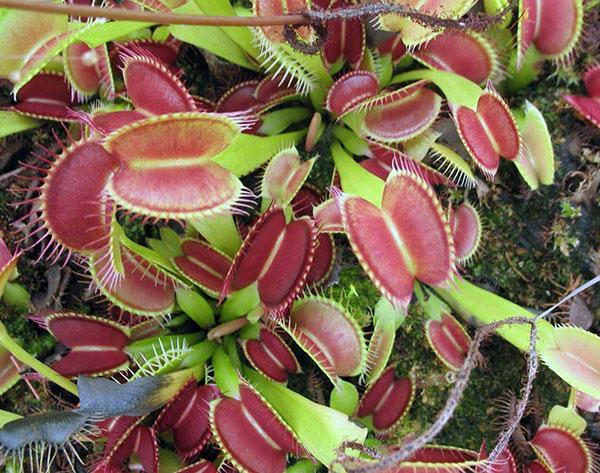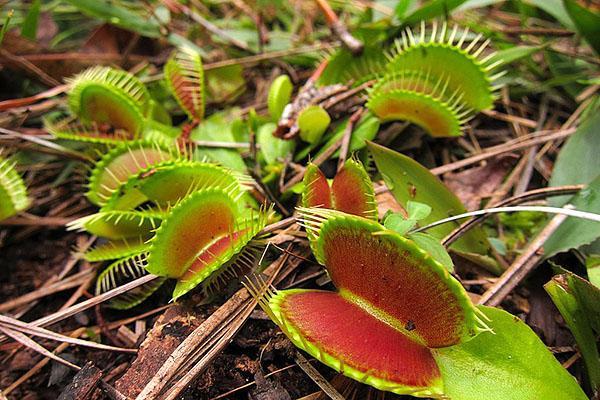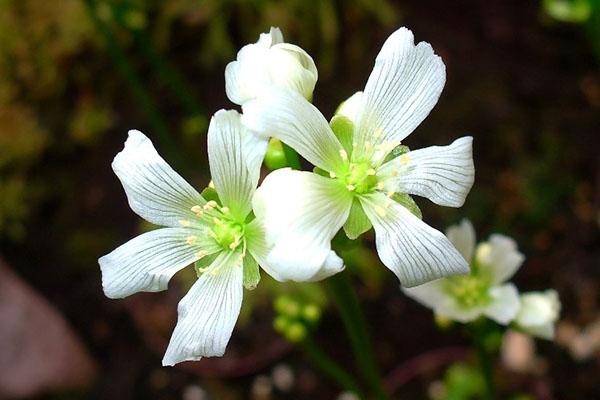Charming carnivorous plant - Venus flytrap
 When we think of predators, we immediately imagine a wolf, lion or shark. Hardly anyone would think of the charming Venus flytrap plant. Although it is considered the most popular among insectivorous representatives of the flora, it would not hurt to get to know it better.
When we think of predators, we immediately imagine a wolf, lion or shark. Hardly anyone would think of the charming Venus flytrap plant. Although it is considered the most popular among insectivorous representatives of the flora, it would not hurt to get to know it better.

Meet the adorable predator
 Venus flytrap belongs to the species of insectivorous representatives of the plant world, the Rosyankovye family. It grows up to 15 cm in height. Has bulbous stems. Snow-white buds are collected in inflorescences that appear on a long flowering shoot.
Venus flytrap belongs to the species of insectivorous representatives of the plant world, the Rosyankovye family. It grows up to 15 cm in height. Has bulbous stems. Snow-white buds are collected in inflorescences that appear on a long flowering shoot.
Since the predator plant grows in its natural environment on soil, where there is not enough nitrogen, it needs special feeding. Various insects, slugs and even mollusks make up for the lack of this element.
 The leaves are a kind of visiting card of the predatory plant Venus flytrap. It is interesting that on one specimen they are of different types, but each is very important for the favorable development of the flower. When spring comes, 4 or 7 leaves grow from a short underground stem, which form a pretty rosette. Over time, long shoots with white inflorescences appear on it. During the flowering period, the rosettes die off and dense leaf plates grow in their place. They are a great support for future traps.
The leaves are a kind of visiting card of the predatory plant Venus flytrap. It is interesting that on one specimen they are of different types, but each is very important for the favorable development of the flower. When spring comes, 4 or 7 leaves grow from a short underground stem, which form a pretty rosette. Over time, long shoots with white inflorescences appear on it. During the flowering period, the rosettes die off and dense leaf plates grow in their place. They are a great support for future traps.
 An original "trap" for careless insects is formed at the tips of young rosette leaves. As summer approaches, they become longer, standing vertically to the outlet. The traps themselves consist of two plates, which are framed by sharp spikes. The inside is covered with fine hairs that secrete nectar.
An original "trap" for careless insects is formed at the tips of young rosette leaves. As summer approaches, they become longer, standing vertically to the outlet. The traps themselves consist of two plates, which are framed by sharp spikes. The inside is covered with fine hairs that secrete nectar.
 The insect flies to a pleasant aroma and becomes a delicious delicacy of a predatory flower - Venus flytrap. A light touch on the sensitive bristles causes the trap to snap shut instantly. The leaves close and the insect dies over time. Interestingly, within only 30 seconds, the plant determines the type of victim trapped. If it is a dry leaf, branch or water, the flaps open, and if it is small living creatures, it is time to start the meal.
The insect flies to a pleasant aroma and becomes a delicious delicacy of a predatory flower - Venus flytrap. A light touch on the sensitive bristles causes the trap to snap shut instantly. The leaves close and the insect dies over time. Interestingly, within only 30 seconds, the plant determines the type of victim trapped. If it is a dry leaf, branch or water, the flaps open, and if it is small living creatures, it is time to start the meal.

The insect processing process takes up to 5 days. Some are over-etched for a whole week or even 10 days. After full saturation of the Dioneus - the Venus flytrap - opens its exotic "jaws", waiting for a new victim.
The trap ceases to work if at least 3 digestion processes have occurred in it. Some flycatchers can digest up to 7 insects in a row.
 An exotic plant grows on the territory of Russia, mainly on window sills in residential buildings, and sometimes it is also found on personal plots. Within the main species, plants have some differences:
An exotic plant grows on the territory of Russia, mainly on window sills in residential buildings, and sometimes it is also found on personal plots. Within the main species, plants have some differences:
- coloring traps;
- direction relative to the outlet (vertical or horizontal);
- the number of valves (two or three).
On the basis of these data, the original varieties of the flower, the Venus flytrap, were bred, the description of which helps to imagine them.
Akai Riu
 This type of Dionea is distinguished by red leaf plates and traps. The hue does not change with the light. It always stays rich and juicy. A thin green line is visible on the outside of the cute trap.
This type of Dionea is distinguished by red leaf plates and traps. The hue does not change with the light. It always stays rich and juicy. A thin green line is visible on the outside of the cute trap.
Dante Trap
 This plant grows no more than 10 cm, but it has more than a dozen miniature traps. They are located vertically to the leaf outlet. The outside of the trap is painted a deep green, along which a red line runs. The inside is usually scarlet.
This plant grows no more than 10 cm, but it has more than a dozen miniature traps. They are located vertically to the leaf outlet. The outside of the trap is painted a deep green, along which a red line runs. The inside is usually scarlet.
Funnel Trap
 The originality lies in the fact that different types of traps are formed on one plant. When the "predator" is still young, all the elements of the plant are colored green. Only a few years later, the traps turn red.
The originality lies in the fact that different types of traps are formed on one plant. When the "predator" is still young, all the elements of the plant are colored green. Only a few years later, the traps turn red.
Giant
 The variety is characterized by traps up to 5 cm in length. They form quickly enough on a predatory plant. At first, the flaps are painted in a bright color, but over time they become dark red.
The variety is characterized by traps up to 5 cm in length. They form quickly enough on a predatory plant. At first, the flaps are painted in a bright color, but over time they become dark red.
Dracula
 The flower has luscious green leaf plates. The trap is red on the inside and green on the outside. An elegant red stripe runs along the outside along the miniature spikes. A truly charming variety.
The flower has luscious green leaf plates. The trap is red on the inside and green on the outside. An elegant red stripe runs along the outside along the miniature spikes. A truly charming variety.
Crocodile
 Dionea has horizontal leaves and traps that are bright green. The inner region, in young specimens, is usually pink, but later becomes more reddish.
Dionea has horizontal leaves and traps that are bright green. The inner region, in young specimens, is usually pink, but later becomes more reddish.
Triton
 The variety is distinguished by an unusual type of traps. They are slightly elongated and open only on one side. They often stick together arbitrarily.
The variety is distinguished by an unusual type of traps. They are slightly elongated and open only on one side. They often stick together arbitrarily.
Rules for caring for an unusual plant
 To successfully raise a charming predator at home, you need to create favorable conditions for her. To do this, you need to choose a suitable place. By far the best option is window sill, since the plant needs sunlight for at least 5 hours a day. If it is not enough, additional lighting should be arranged. Some color lovers grow "predators" in terrariums to create the right moisture. In this case backlight required.
To successfully raise a charming predator at home, you need to create favorable conditions for her. To do this, you need to choose a suitable place. By far the best option is window sill, since the plant needs sunlight for at least 5 hours a day. If it is not enough, additional lighting should be arranged. Some color lovers grow "predators" in terrariums to create the right moisture. In this case backlight required.
The window should face east or west. Otherwise, the plant may get sick.
 With proper home care, the Venus flytrap takes root well on the balcony in the summer. In this case, the temperature should be controlled. In summer, it can reach a maximum of 30 degrees Celsius, in winter - only up to 7 ° C. If the plant is indoors, it should be regularly ventilated, but without drafts. The flycatcher does not like sudden movements and extreme situations.
With proper home care, the Venus flytrap takes root well on the balcony in the summer. In this case, the temperature should be controlled. In summer, it can reach a maximum of 30 degrees Celsius, in winter - only up to 7 ° C. If the plant is indoors, it should be regularly ventilated, but without drafts. The flycatcher does not like sudden movements and extreme situations.
It is better to water Dionea with rainwater (you can use distilled water). The natural liquid is collected in plastic containers, defended, and then used for watering. The soil in the plant pot should always be moist. With a lack of it, traps can die.
The best way to replenish the amount of moisture in the pot is to place it in a container of water. The flower will independently absorb the required amount of moisture for active growth.
 Interestingly, the plant does not need additional fertilizing. After all, she receives important elements by feeding on various insects. For the entire growing season, it is enough to feed the plant with two or three live flies, mosquitoes or small spiders. The Venus flytrap shown in the photo feels great after such a meal.
Interestingly, the plant does not need additional fertilizing. After all, she receives important elements by feeding on various insects. For the entire growing season, it is enough to feed the plant with two or three live flies, mosquitoes or small spiders. The Venus flytrap shown in the photo feels great after such a meal.
Recommendations for growing an overseas plant
 To grow a dionea at home, you need to follow simple guidelines. When spring comes, the plant blooms in lush white inflorescences. They need to carry out pollination by hand, doing it carefully, but carefully.A month later, miniature boxes with planting material are formed on the pedicels. 90 days after pollination, flowers can be planted in pots.
To grow a dionea at home, you need to follow simple guidelines. When spring comes, the plant blooms in lush white inflorescences. They need to carry out pollination by hand, doing it carefully, but carefully.A month later, miniature boxes with planting material are formed on the pedicels. 90 days after pollination, flowers can be planted in pots.
If you know how to grow a Venus flytrap from seeds, an exotic "predator" will appear in the house to the delight of the household. They should be sown in warm soil consisting of sand and sphagnum moss. The containers are placed in a special greenhouse. For 20 days, it is advisable to ensure that the soil does not dry out. If the seeds of the Venus flytrap are planted densely, the seedlings will have to be planted. 2-3 plants are placed in each separate pot. There they develop for about 3 years before fully maturing.
 In order for Dionea to be able to delight household members for a long time, she needs a regular rest period of about 3 months. The dormant plant doesn't look very attractive. Some even think it is dying. The overwintering of the Venus flytrap begins when the plant stops growing. The leaves darken, turning brown and dry out over time. They should be trimmed.
In order for Dionea to be able to delight household members for a long time, she needs a regular rest period of about 3 months. The dormant plant doesn't look very attractive. Some even think it is dying. The overwintering of the Venus flytrap begins when the plant stops growing. The leaves darken, turning brown and dry out over time. They should be trimmed.
 Usually, winter dormancy lasts from late autumn (November) to the end of February. All this time, the plant is moderately watered, preventing the substrate from drying out. It also needs daylight, albeit in less quantity. The temperature in the room where the flycatcher hibernates should be no higher than 8 degrees. When winter ends and the days get longer, the plant comes to life. Tender shoots appear, which will grow only at the end of spring. And a charming predatory plant will again settle in the house - the Venus flytrap.
Usually, winter dormancy lasts from late autumn (November) to the end of February. All this time, the plant is moderately watered, preventing the substrate from drying out. It also needs daylight, albeit in less quantity. The temperature in the room where the flycatcher hibernates should be no higher than 8 degrees. When winter ends and the days get longer, the plant comes to life. Tender shoots appear, which will grow only at the end of spring. And a charming predatory plant will again settle in the house - the Venus flytrap.